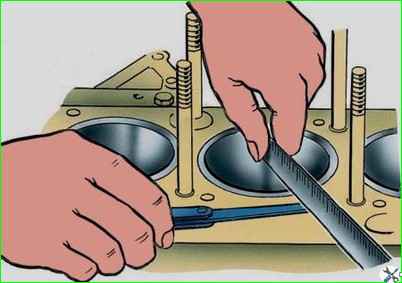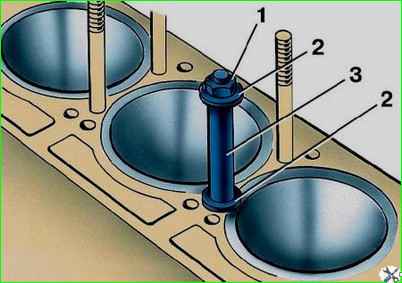Mating of wearing parts is carried out mainly with replaceable parts, which makes it possible to repair the cylinder block by regrinding or replacing liners, replacing worn camshaft bushings with semi-finished ones and then processing them to the required size, replacing crankshaft main bearing shells
Restoring the functionality of the pair of cylinder block bores and pushers due to their slight wear comes down to replacing the pushers.
Repair and replacement of cylinder block liners
The maximum permissible wear of cylinder liners should be considered to be an increase in the gap between the liner and the piston skirt to 0.3 mm.

If there is such wear, press the liner out of the cylinder block using puller 1 (Fig. 1) and bore it to the nearest repair size of the piston with a processing tolerance of +0.06 mm.
Do not clamp the sleeve into the jaw chuck when processing, as this will cause deformation of the sleeve and distortion of its dimensions.
Secure the sleeve in a device, which is a sleeve with seating belts with a diameter of 100 and 108 mm.
Insert the sleeve into the sleeve until it stops at the upper collar, which is clamped with an overlay ring in the axial direction.
After processing, the liner cylinder mirror should have the following deviations:
- 1. Ovality and taper are not more than 0.01 mm, and the larger base of the cone should be located in the lower part of the sleeve.
- 2. Barrel shape and corsetry - no more than 0.08 mm.
- 3. The runout of the cylinder mirror relative to the seating belts with a diameter of 100 and 108 mm is no more than 0.01 mm.

After pressing the liner into the cylinder block, check the amount of protrusion of the upper end of the liner above the upper plane of the block (Fig. 2).
The amount of protrusion should be 0.005–0.055 mm.
If the protrusion is insufficient (less than 0.005 mm), the head gasket may be punctured; in addition, coolant will inevitably enter the combustion chamber due to insufficient sealing of the upper flange of the liner with the cylinder block.
When checking the amount of protrusion of the end of the sleeve above the block, it is necessary to remove the rubber o-ring from the sleeve.

To prevent the liners from falling out of the sockets in the block during repairs, secure them using washers 2 and bushings 3, put on the studs securing the cylinder head, as shown in Fig. 3.
Cylinder liners, bored to the third repair size of the piston, after wear, replace with new ones.





